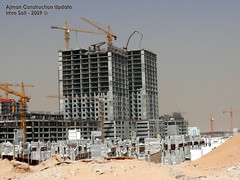Tomorrow will be the grand opening of the latest addition to the skyline of Dubai, United Arab Emirates (UAE). The Atlantis Palm Resort, with over 1,500 rooms, will be hosting an opening ceremony with celebrities from around the world tomorrow night. The rapid development in Dubai and across the UAE hasn't all been easy lately, as infrastructure problems (handling rising levels of waste to match massive development), and world financial struggles have slowed progress. Wealthy Dubai continues to grow though, in both land area as new islands are built, and in height as new, taller skyscrapers are planned to best the Burj Dubai, already the tallest in the world.
An Emirati man holds a falcon during the Abu Dhabi International Hunting and Equestrian Exhibition in Abu Dhabi. The annual exhibition has achieved great success both within the Gulf region and worldwide attracting international specialist exhibitors of guns, hunting vehicles, shooting, fishing, falconry, equipment and accessories.
British motorcyclist James West drives his 690 cc KTM Rally bike during preliminary super stage action in Dubai, one day before the official start of the UAE Desert Challenge Rally. More than 140 drivers took part in the five day rally.
The Queen Elizabeth 2 cruise liner enters the Firth of Clyde past Cumbrea Elbow lighthouse. The ship is making its final journey in November to Dubai to be re-fitted as a luxury floating hotel anchored off Palm Jumeirah, the world's largest man-made island.
A sculpture of an ant is seen in front of the Dubai International Financial Exchange. Gulf Arab stock markets had slumped to multi-year lows as speculation intensified that a five-year property boom had come to an end and heavyweight financing firms would be forced to merge as credit conditions deteriorated.
With a background of Sheikh Zayed highway's towers, Muslims of different nationalities perform the Eid al-Fitr prayers at Grand Musalla in Dubai, United Arab Emirates,.
Visitors look at a model of a proposed development entitled "City of Arabia" at the opening of the Cityscape 2008 international real estate exhibition in Dubai.
A man walks close to a polluted beach in the popular Jumeirah area in the Gulf Emirate of Dubai. News of a serious sea water pollution is causing worries in Dubai, especially after the municipality closed off one of the most popular beaches in the emirate.
With the world's tallest under construction tower, Burj Dubai, background left, vehicles pass by the under construction towers at the Business Bay in Dubai, United Arab Emirates.
Arab clients smoke waterpipes after breaking their fast at a Ramadan tent in a five-star hotel in Dubai. Besides charity banquets for the poor during the fasting month of Ramadan, fancy tents that offer sumptuous meals at relevant prices flourish in the oil-rich Gulf emirate, attracting both locals and foreigners, Muslims and non-Muslims, many of whom exchange normal dinner outings with the sunset 'iftar' meal and late night 'suhur' snacks and waterpipes.
Burj Dubai, the tallest tower in the world, is seen in the background as labourers work at a construction site near the Dubai Mall. The Dubai Mall, one of the world's largest, has pushed back its opening on October 30 to five days later.
A handout picture made available on October 26, 2008 from the media office of Sheikh Mohammad bin Rashed al-Maktoum shows Sheikh Mohammad bin Rashid al-Maktoum, Vice President, Prime Minister and Defence Minister of the United Arab Emirates and Ruler of Dubai, walking through an aisle of the second Emirates Airline A380 superjumbo at Dubai international airport. The rich Gulf Emirate received the second A380 on October 24, 2008. Emirates, which is owned by the government of Dubai, is the largest customer of the A380. It has 58 on order in a deal worth about 18.8 billion dollars based on list prices.
Sultan Ahmed bin Sulayem, Chairman of Dubai World, talks to the audience about the Nakheel Harbour & Tower project, a more than 1 kilometer high tower in Dubai, United Arab Emirates,
A handout picture made available by the Dubai Desert Challenge shows Russian driver Vladimir Chagin and his co-pilots Sergy Savostin and Antoly Tahin driving their Kamaz 4911 truck through the Liwa desert, south of Abu Dhabi, during the UAE Desert challenge Competition.
The scene over Dubai Marina. Dubai property shares plunged, last week, and its biggest private developer slashed jobs as the global financial crisis tightened its grip on the tiny emirate, until now synonymous with the Gulf Arab real estate boom.
Visitors looks up as fish swim in the aquarium tunnel in Dubai Mall, which covers the area of 50 soccer fields. The Dubai Mall, which officially opened on the 4th, includes the aquarium, one of the world's largest, an Olympic-sized ice rink, a gold souq and shops covering 5.9 million sq ft.
With a background of Sheikh Zayed highway's towers, Muslim women arrive at Grand Musalla to perform the Eid al-Fitr prayers in Dubai, United Arab Emirates.
A handout picture made available by EMAAR Malls Group shows an aerial view of Dubai Mall, one of the world�s largest shopping and entertainment destinations in the booming Gulf state.
An Emirati carries a falcon, one of the tourist attractions at the lobby of the Atlantis resort complex on the man-made Palm Jumeirah island in the Gulf emirate of Dubai.
Journalists watch a stingray swimming in the giant aquarium of the Atlantis hotel which is a part of $ 1.5 billion resort in Jumeira Palm Island in Dubai, United Arab Emirates.
An early evening view of the Atlantis Hotel on the Palm Jumeirah with residential construction in the foreground.

















































